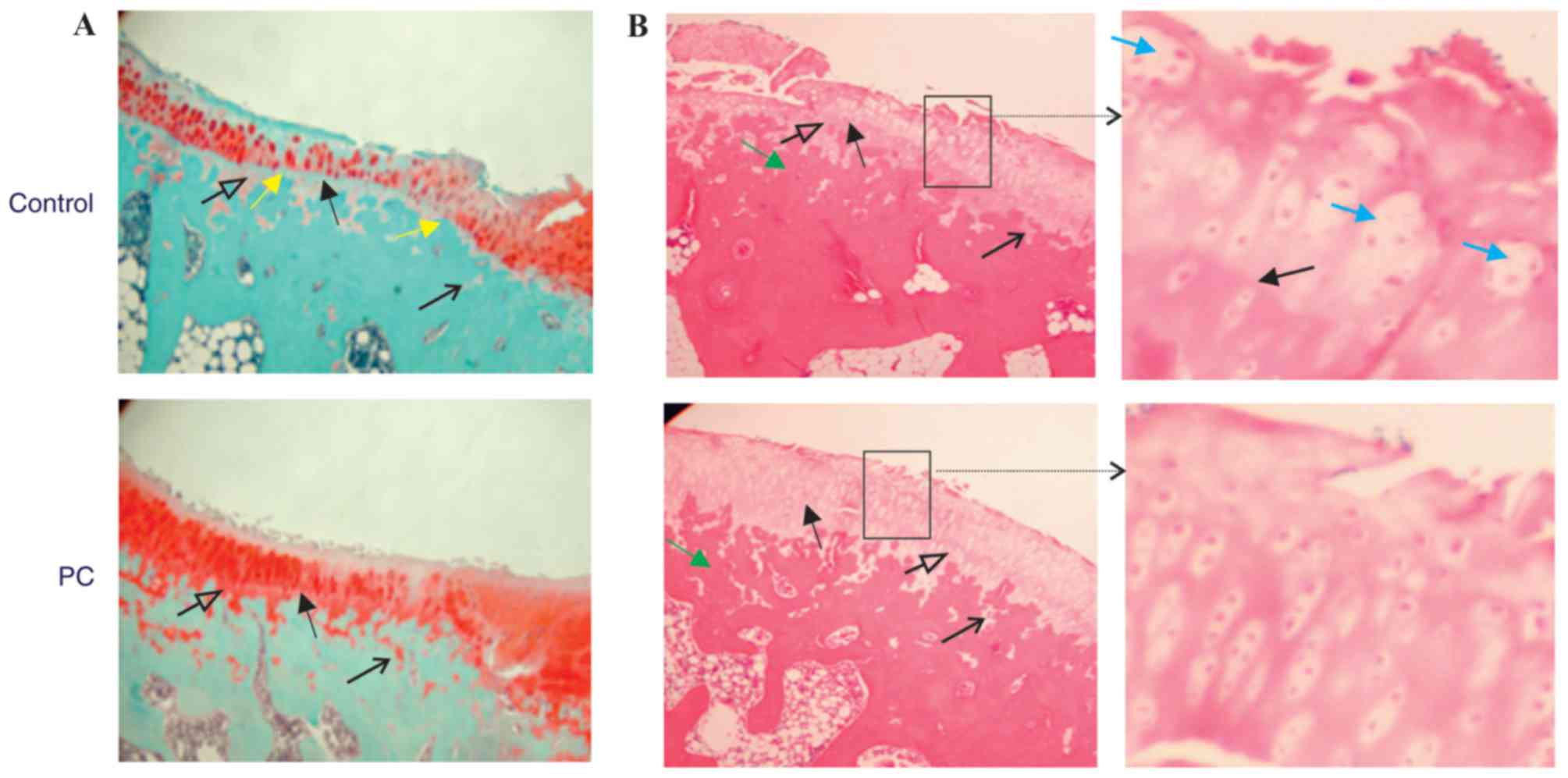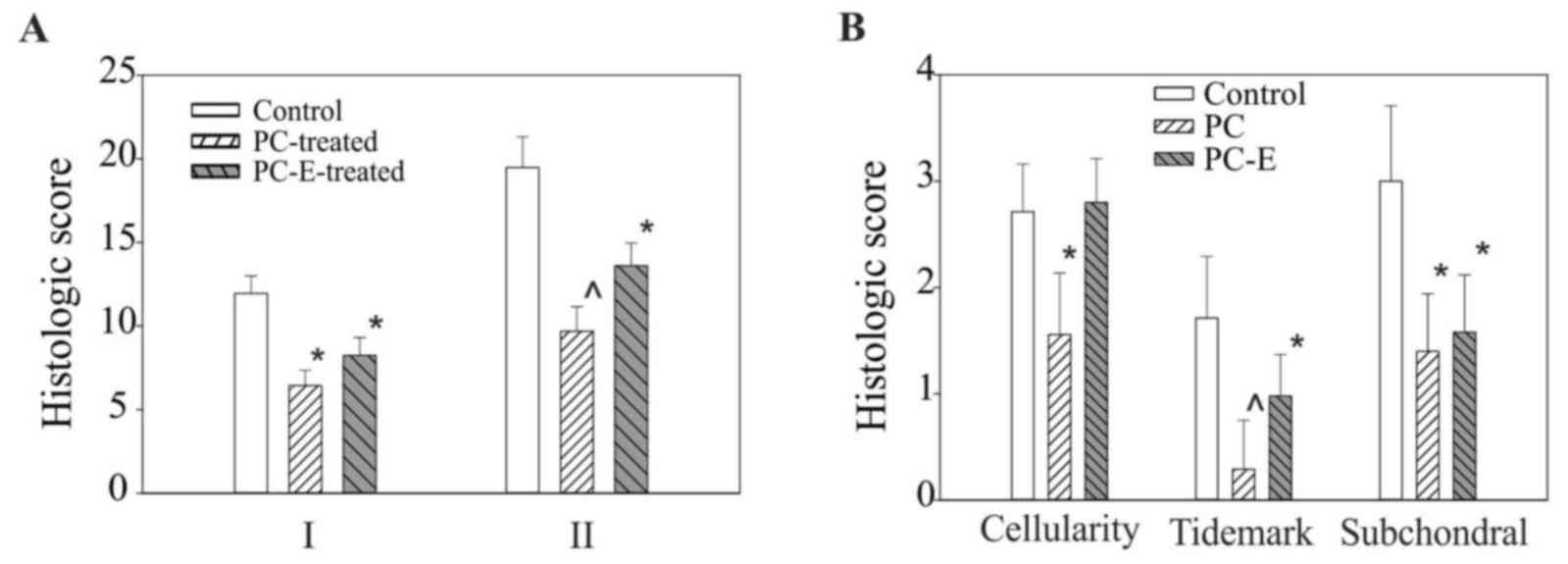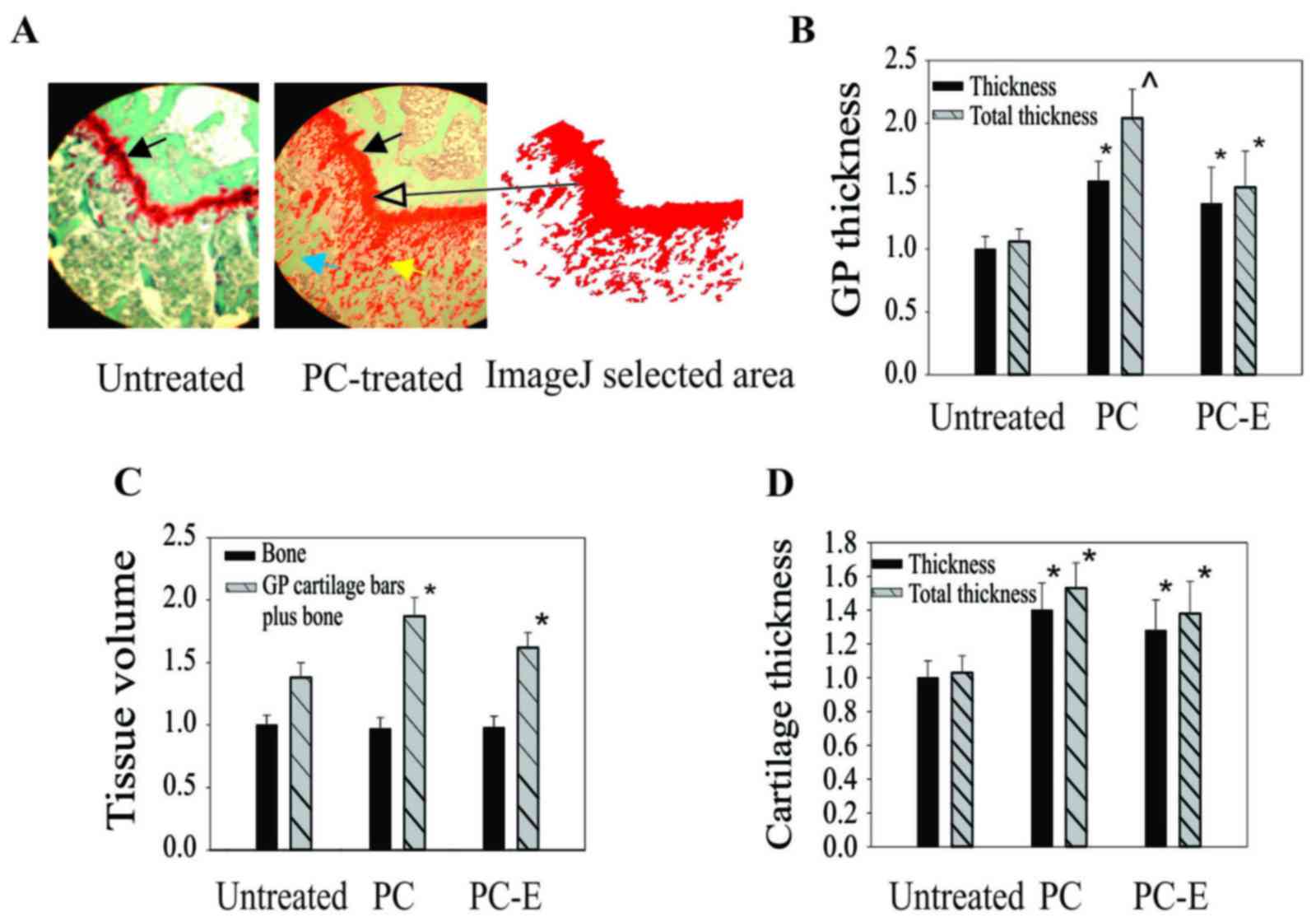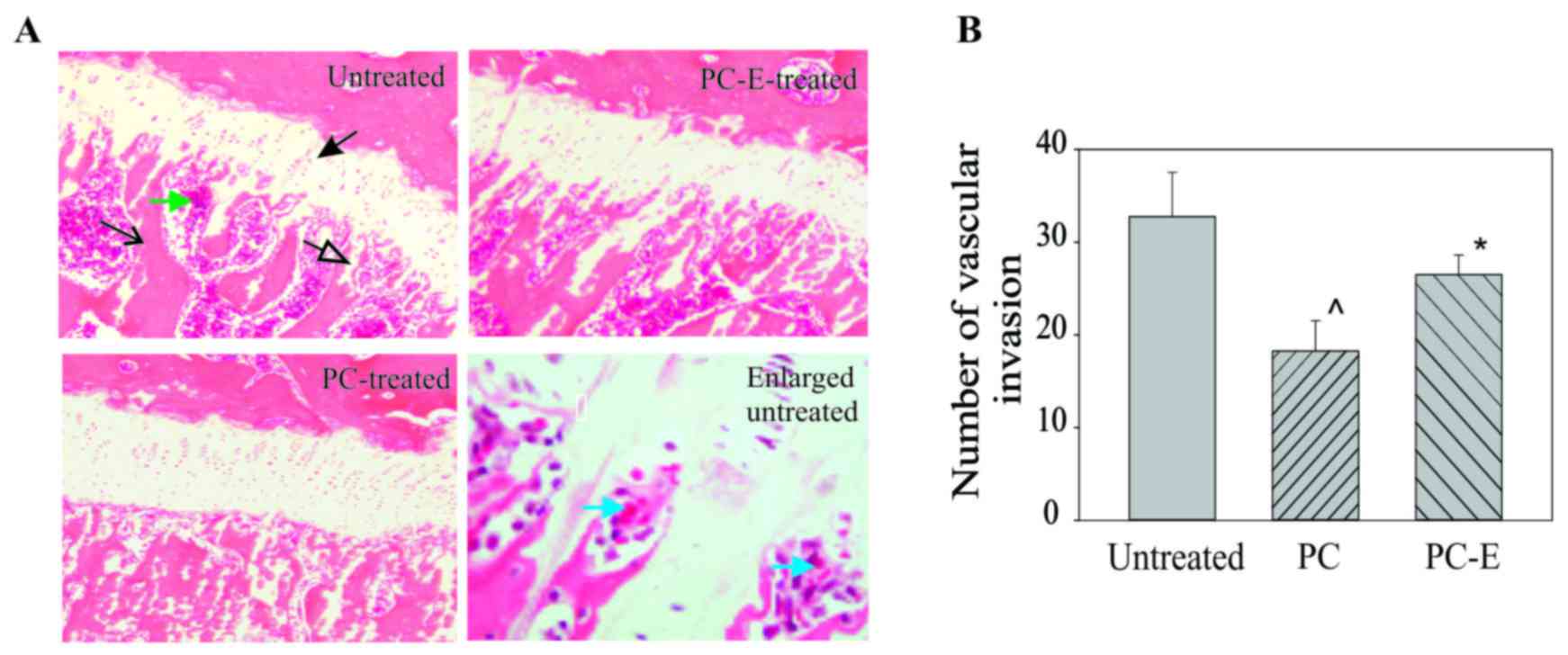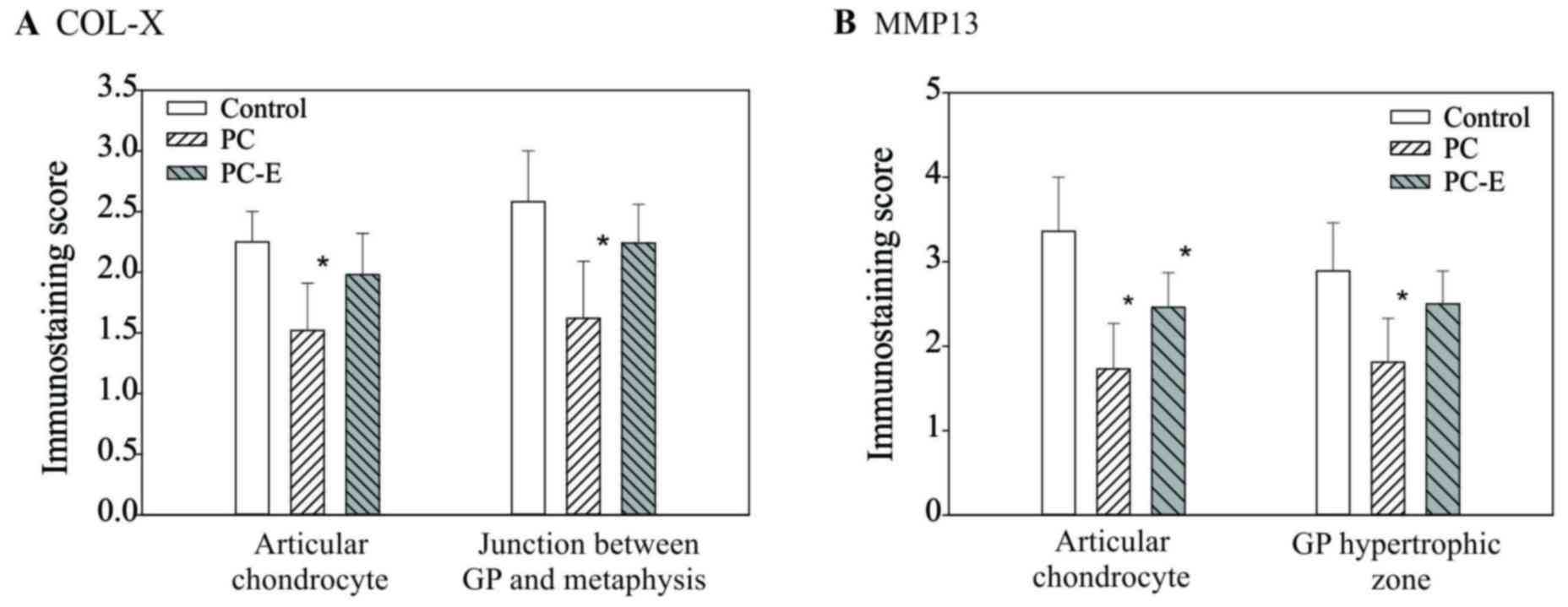|
1
|
Brown TD, Johnston RC, Saltzman CL, Marsh
JL and Buckwalter JA: Posttraumatic osteoarthritis: A first
estimate of incidence, prevalence, and burden of disease. J Orthop
Trauma. 20:739–744. 2006. View Article : Google Scholar : PubMed/NCBI
|
|
2
|
Olney RC: Mechanisms of impaired growth:
Effect of steroids on bone and cartilage. Horm Res. 72 Suppl
1:S30–S35. 2009. View Article : Google Scholar
|
|
3
|
Goldring MB, Otero M, Plumb DA, Dragomir
C, Favero M, El Hachem K, Hashimoto K, Roach HI, Olivotto E, Borzì
RM and Marcu KB: Roles of inflammatory and anabolic cytokines in
cartilage metabolism: Signals and multiple effectors converge upon
MMP-13 regulation in osteoarthritis. Eur Cell Mater. 21:202–220.
2011. View Article : Google Scholar : PubMed/NCBI
|
|
4
|
Martel-Pelletier J, Welsch DJ and
Pelletier JP: Metalloproteases and inhibitors in arthritic
diseases. Best Pract Res Clin Rheumatol. 15:805–829. 2001.
View Article : Google Scholar : PubMed/NCBI
|
|
5
|
Burrage PS and Brinckerhoff CE: Molecular
targets in osteoarthritis: Metalloproteinases and their inhibitors.
Curr Drug Targets. 8:293–303. 2007. View Article : Google Scholar : PubMed/NCBI
|
|
6
|
Lotz MK, Otsuki S, Grogan SP, Sah R,
Terkeltaub R and D'Lima D: Cartilage cell clusters. Arthritis
Rheum. 62:2206–2218. 2010. View Article : Google Scholar : PubMed/NCBI
|
|
7
|
van der Kraan PM and van den Berg WB:
Chondrocyte hypertrophy and osteoarthritis: Role in initiation and
progression of cartilage degeneration? Osteoarthritis Cartilage.
20:223–232. 2012. View Article : Google Scholar : PubMed/NCBI
|
|
8
|
Tchetina EV, Squires G and Poole AR:
Increased type II collagen degradation and very early focal
cartilage degeneration is associated with upregulation of
chondrocyte differentiation related genes in early human articular
cartilage lesions. J Rheumatol. 32:876–886. 2005.PubMed/NCBI
|
|
9
|
Bertrand J, Cromme C, Umlauf D, Frank S
and Pap T: Molecular mechanisms of cartilage remodelling in
osteoarthritis. Int J Biochem Cell Biol. 42:1594–1601. 2010.
View Article : Google Scholar : PubMed/NCBI
|
|
10
|
Clark JM: The structure of vascular
channels in the subchondral plate. J Anat. 171:105–115.
1990.PubMed/NCBI
|
|
11
|
Kawaguchi H: Endochondral ossification
signals in cartilage degradation during osteoarthritis progression
in experimental mouse models. Mol Cells. 25:1–6. 2008.PubMed/NCBI
|
|
12
|
D'Angelo M, Yan Z, Nooreyazdan M, Pacifici
M, Sarment DS, Billings PC and Leboy PS: MMP-13 is induced during
chondrocyte hypertrophy. J Cell Biochem. 77:678–693. 2000.
View Article : Google Scholar : PubMed/NCBI
|
|
13
|
Inada M, Wang Y, Byrne MH, Rahman MU,
Miyaura C, López-Otín C and Krane SM: Critical roles for
collagenase-3 (Mmp13) in development of growth plate cartilage and
in endochondral ossification. Proc Natl Acad Sci USA. 101:pp.
17192–17197. 2004; View Article : Google Scholar : PubMed/NCBI
|
|
14
|
Wei F, Zhou J, Wei X, Zhang J, Fleming BC,
Terek R, Pei M, Chen Q, Liu T and Wei L: Activation of Indian
hedgehog promotes chondrocyte hypertrophy and upregulation of
MMP-13 in human osteoarthritic cartilage. Osteoarthritis Cartilage.
20:755–763. 2012. View Article : Google Scholar : PubMed/NCBI
|
|
15
|
Lane LB and Bullough PG: Age-related
changes in the thickness of the calcified zone and the number of
tidemarks in adult human articular cartilage. J Bone Joint Surg Br.
62:372–375. 1980.PubMed/NCBI
|
|
16
|
Oettmeier R, Abendroth K and Oettmeier S:
Analyses of the tidemark on human femoral heads. II. Tidemark
changes in osteoarthrosis-a histological and histomorphometric
study in non-decalcified preparations. Acta Morphol Hung.
37:169–180. 1989.PubMed/NCBI
|
|
17
|
Staines KA, Pollard AS, McGonnell IM,
Farquharson C and Pitsillides AA: Cartilage to bone transitions in
health and disease. J Endocrinol. 219:R1–R12. 2013. View Article : Google Scholar : PubMed/NCBI
|
|
18
|
Williams G and Sallis JD: Structural
factors influencing the ability of compounds to inhibit
hydroxyapatite formation. Calcif Tissue Int. 34:169–177. 1982.
View Article : Google Scholar : PubMed/NCBI
|
|
19
|
Shankar R, Crowden S and Sallis JD:
Phosphocitrate and its analogue N-sulpho-2-amino tricarballylate
inhibit aortic calcification. Atherosclerosis. 52:191–198. 1984.
View Article : Google Scholar : PubMed/NCBI
|
|
20
|
Sallis JD, Shankar R, Rees B and Thomson
R: Protection of crystal-induced polymorphonuclear leukocyte
membranolysis by phosphocitrate. Biochem Med Metab Biol. 41:56–63.
1989. View Article : Google Scholar : PubMed/NCBI
|
|
21
|
Nair D, Misra RP, Sallis JD and Cheung HS:
Phosphocitrate inhibits a basic calcium phosphate and calcium
pyrophosphate dihydrate crystal-induced mitogen-activated protein
kinase cascade signal transduction pathway. J Biol Chem.
272:18920–18925. 1997. View Article : Google Scholar : PubMed/NCBI
|
|
22
|
Cheung HS, Sallis JD and Struve JA:
Specific inhibition of basic calcium phosphate and calcium
pyrophosphate crystal-induction of metalloproteinase synthesis by
phosphocitrate. Biochim Biophys Acta. 1315:105–111. 1996.
View Article : Google Scholar : PubMed/NCBI
|
|
23
|
Sun Y, Reuben P, Wenger L, Sallis JD,
Demadis KD and Cheung HS: Inhibition of calcium phosphate-DNA
coprecipitates induced cell death by phosphocitrates. Front Biosci.
10:803–808. 2005. View
Article : Google Scholar : PubMed/NCBI
|
|
24
|
Cheung HS: Phosphocitrate as a potential
therapeutic strategy for crystal deposition disease. Curr Rheumatol
Rep. 3:24–28. 2001. View Article : Google Scholar : PubMed/NCBI
|
|
25
|
Cheung HS, Sallis JD, Demadis KD and
Wierzbicki A: Phosphocitrate blocks calcification-induced articular
joint degeneration in a guinea pig model. Arthritis Rheum.
54:2452–2461. 2006. View Article : Google Scholar : PubMed/NCBI
|
|
26
|
Sun Y, Mauerhan DR, Franklin AM, Norton J,
Hanley EN Jr and Gruber HE: Phosphocitrate is potentially a
disease-modifying drug for noncrystal-associated osteoarthritis.
Biomed Res Int. 2013:3262672013. View Article : Google Scholar : PubMed/NCBI
|
|
27
|
Sun Y, Roberts A, Mauerhan DR, Sun AR,
Norton HJ and Hanley EN Jr: Biological activities of
phosphocitrate: A potential meniscal protective agent. Biomed Res
Int. 2013:7265812013. View Article : Google Scholar : PubMed/NCBI
|
|
28
|
Sun Y, Mauerhan DR, Steuerwald NM, Ingram
J, Kneisl JS and Hanley EN Jr: Expression of
phosphocitrate-targeted genes in osteoarthritis menisci. Biomed Res
Int. 2014:2104692014. View Article : Google Scholar : PubMed/NCBI
|
|
29
|
Turhanen PA, Demadis KD, Peräniemi S and
Vepsäläinen JJ: A novel strategy for the preparation of naturally
occuring phosphocitrate and its partially esterified derivatives. J
Org Chem. 72:1468–1471. 2007. View Article : Google Scholar : PubMed/NCBI
|
|
30
|
Bendele AM, White SL and Hulman JF:
Osteoarthrosis in guinea pigs: Histopathologic and scanning
electron microscopic features. Lab Anim Sci. 39:115–121.
1989.PubMed/NCBI
|
|
31
|
Kuyinu EL, Narayanan G, Nair LS and
Laurencin CT: Animal models of osteoarthritis: Classification,
update and measurement of outcomes. J Orthop Surg Res. 11:192016.
View Article : Google Scholar : PubMed/NCBI
|
|
32
|
Poole R, Blake S, Buschmann M, Goldring S,
Laverty S, Lockwood S, Matyas J, McDougall J, Pritzker K, Rudolphi
K, et al: Recommendations for the use of preclinical models in the
study and treatment of osteoarthritis. Osteoarthritis Cartilage. 18
Suppl 3:S10–S16. 2010. View Article : Google Scholar : PubMed/NCBI
|
|
33
|
Jimenez PA, Glasson SS, Trubetskoy OV and
Haimes HB: Spontaneous osteoarthritis in Dunkin Hartley guinea
pigs: Histologic, radiologic and biochemical changes. Lab Anim Sci.
47:598–601. 1997.PubMed/NCBI
|
|
34
|
Huebner JL, Seifer DR and Kraus VB: A
longitudinal analysis of serum cytokines in the Hartley guinea pig
model of osteoarthritis. Osteoarthritis Cartilage. 15:354–356.
2007. View Article : Google Scholar : PubMed/NCBI
|
|
35
|
Thomsen JS, Straarup TS, Danielsen CC,
Oxlund H and Brüel A: No effect of risedronate on articular
cartilage damage in the Dunkin Hartley guinea pig model of
osteoarthritis. Scand J Rheumatol. 42:408–416. 2013. View Article : Google Scholar : PubMed/NCBI
|
|
36
|
Thomsen JS, Straarup TS, Danielsen CC,
Oxlund H and Brüel A: Relationship between articular cartilage
damage and subchondral bone properties and meniscal ossification in
the Dunkin Hartley guinea pig model of osteoarthritis. Scand J
Rheumatol. 40:391–399. 2011. View Article : Google Scholar : PubMed/NCBI
|
|
37
|
Horcajada MN, Sanchez C, Membrez Scalfo F,
Drion P, Comblain F, Taralla S, Donneau AF, Offord EA and Henrotin
Y: Oleuropein or rutin consumption decreases the spontaneous
development of osteoarthritis in the Hartley guinea pig.
Osteoarthritis Cartilage. 23:94–102. 2015. View Article : Google Scholar : PubMed/NCBI
|
|
38
|
Sun Y, Haines N, Roberts A, Ruffolo M,
Mauerhan DR, Mihalko KL, Ingram J, Cox M and Hanley EN Jr:
Disease-modifying effects of phosphocitrate and
phosphocitrate-beta-ethyl ester on partial meniscectomy-induced
osteoarthritis. BMC Musculoskelet Disord. 16:2702015. View Article : Google Scholar : PubMed/NCBI
|
|
39
|
Huebner JL, Hanes MA, Beekman B, TeKoppele
JM and Kraus VB: A comparative analysis of bone and cartilage
metabolism in two strains of guinea-pig with varying degrees of
naturally occurring osteoarthritis. Osteoarthritis Cartilage.
10:758–767. 2002. View Article : Google Scholar : PubMed/NCBI
|
|
40
|
Sun Y, Mauerhan DR, Kneisl JS, Norton HJ,
Zinchenko N and Ingram JA: Histologic evidence for collagen and
proteoglycan changes in menisci of osteoarthritic patients.
Proceedings of the ACR/ARHP 75th Annual Scientific Meeting.
Chicago, IL. 2011;
|
|
41
|
Kirsch T, Swoboda B and Nah H: Activation
of annexin II and V expression, terminal differentiation,
mineralization and apoptosis in human osteoarthritic cartilage.
Osteoarthritis Cartilage. 8:294–302. 2000. View Article : Google Scholar : PubMed/NCBI
|
|
42
|
Kim HA, Lee YJ, Seong SC, Choe KW and Song
YW: Apoptotic chondrocyte death in human osteoarthritis. J
Rheumatol. 27:455–462. 2000.PubMed/NCBI
|
|
43
|
Kouri JB, Aguilera JM, Reyes J, Lozoya KA
and González S: Apoptotic chondrocytes from osteoarthrotic human
articular cartilage and abnormal calcification of subchondral bone.
J Rheumatol. 27:1005–1019. 2000.PubMed/NCBI
|
|
44
|
Sophia Fox AJ, Bedi A and Rodeo SA: The
basic science of articular cartilage: Structure, composition and
function. Sports Health. 1:461–468. 2009. View Article : Google Scholar : PubMed/NCBI
|
|
45
|
Marini S, Fasciglione GF, Monteleone G,
Maiotti M, Tarantino U and Coletta M: A correlation between knee
cartilage degradation observed by arthroscopy and synovial
proteinases activities. Clin Biochem. 36:295–304. 2003. View Article : Google Scholar : PubMed/NCBI
|
|
46
|
Ozler K, Aktas E, Atay C, Yilmaz B, Arikan
M and Güngör Ş: Serum and knee synovial fluid matrix
metalloproteinase-13 and tumor necrosis factor-alpha levels in
patients with late-stage osteoarthritis. Acta Orthop Traumatol
Turc. 50:356–361. 2016. View Article : Google Scholar : PubMed/NCBI
|
|
47
|
Molloy ES, Morgan MP, McDonnell B, O'byrne
J and McCarthy GM: BCP crystals increase prostacyclin production
and upregulate the prostacyclin receptor in OA synovial
fibroblasts: Potential effects on mPGES1 and MMP-13. Osteoarthritis
Cartilage. 15:414–420. 2007. View Article : Google Scholar : PubMed/NCBI
|
|
48
|
Cooper CM and Sallis JD: Studies on the
gastrointestinal absorption of phosphocitrate, a powerful
controller of hydroxyapatite formation. Int J Pharm. 98:165–172.
1993. View Article : Google Scholar
|



